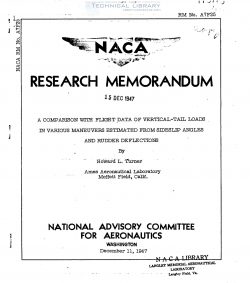naca-rm-a7f25
- Version
- 121 Downloads
- 538.04 KB File Size
- 1 File Count
- April 20, 2017 Create Date
- April 20, 2017 Last Updated
A Comparison with Flight Data of Vertical-Tail Loads in Various Maneuvers Estimated from Sideslip Angles and Rudder Deflections

A comparison is made of the vertical—tail loads deter-
mined from pressure—distribution measurements in flight in
various maneuvers with the corresponding vertical~tail loads
calculated, using the values of sideslip angles and rudder
deflections as measured during the various maneuvers.' The
maneuvers investigated included slow rolls steady sideslips,
fishtails, and rolling pull~outs. The loads were calculated
only for the sideslip angles and rudder deflections corre—
sponding to the maximum measured load in each maneuver. For
the maneuvers investigated, the calculated loads were found
to be conservative by apgaroximately 16 percent as compared
with the experimental loads. The sources of error in the
methods of estimating some of these aerodynamic parameters
and their effects on the vertical~tail load computations are
discussed.briefly.
In several of the more recently proposed methods for
computing critical vertical-tail loads, it is necessary, in
a given type of maneuver to determine the values of sideslip
angle B, the. rudder angle 6?, and-the yawing velocity r,
in order to predict the total vertical-tail loads. Methods for
predicting these values analytically for various types of
maneuvers are presented in references 1, 2, and 3, although
in some of these cases partial verification of the general
method of computing vertical-tail loads is provided by
comparing computed results with values from flight tests
there still remains some uncertainty as to the accuracy with
which the total vertical—tail losds may- be predicted using
available means for estimating aerodynamic parameters from
airpla_ne geometry alone.
In order to provide data to further substantiate the
validity of one step in the pr.ediction ef tail loads, flia eht
tests were conducted. on -s propeller—driven fighter-type nir—
plane- in which ver.tical— teil loads Were measured by orifices
on the surface of the vertical tail, in various sts.tic and
dynamic maneuvers. Simults .neous values of sideslip an gle,
rudder deflection and. yswing velocity were also mes.sured.
From these data and the. aerodynamic parameters evaluated using
the verticel— tail geometry the vertice —teil loads were
computed and then compared with the corresponding loads
measured in flight.
| File | Action |
|---|---|
| naca-rm-a7f25 A Comparison with Flight Data of Vertical-Tail Loads in Various Maneuvers Estimated from Sideslip Angles and Rudder Deflections.pdf | Download |

Comment On This Post